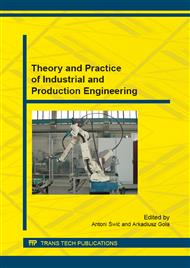[1]
M. Bosansky, I. Kozuch, M. Veres: Hobbing as the possibility of C-C gearing production, The 2nd Int. Conf. Power Transmissions'06, 25-26 April 2006, Novi Sad, 2006, pp.267-270.
Google Scholar
[2]
I. Dudas, The Theory and Practice of Worm Gear Drives, Penton Press, London (2000).
Google Scholar
[3]
Gołębski R.: Analiza geometryczna przekładni ślimakowej walcowej, Doctoral thesis. Czestochowa University of Technology, Częstochowa (2006).
Google Scholar
[4]
A. Koć, J. Misiak: Uniwersalny algorytm optymalizujący konstrukcję i ustawienie narzędzia krążkowego do obróbki, Mechanik 3 (1995) 77-81.
Google Scholar
[5]
Z. Kornberger, Przekładnie ślimakowe, WNT, Warsaw (1962).
Google Scholar
[6]
T. Marciniak, Przekładnie ślimakowe walcowe, Wyd. Naukowe PWN, Warsaw (2001).
Google Scholar
[7]
T. Nieszporek, R. Gołębski, Generowanie powierzchni śrubowej ślimaka, International Scientific & Technical Conference - Gear Wheels 2004, Zeszyty Naukowe, Rzeszow University of Technology 217, 64, (2004) 193-200.
Google Scholar
[8]
F.L. Litvin, A. Fluentes, A., Gear geometry and applied theory, Cambridge University Press, Cambridge, (2004).
Google Scholar
[9]
M. Borzan, R. Ch. Sabau, The calculus of axial profile of cavex worm. Annals of The MTeM for 2003 & Proceedings of the 6th International MTeM Conference, Napoca, Romania 2003, pp.73-74.
Google Scholar
[10]
M. Bosansky, I. Kozuch, M. Veres, Hobbing as the possibility of C-C gearing production, The 2nd Int. Conf. Power Transmissions'06, 25-26 april 2006, Novi Sad, 2006, pp.267-270.
Google Scholar
[11]
F.L. Litvin, Nowyje widy xylindriczeskich czerwiacznych pieredać, Maszgiz, Moskwa (1962).
Google Scholar
[12]
W.C. Ljuszin Люкшин, Teoria wintowych linji i powerchnostiej, MSI, Moskwa (1963).
Google Scholar
[13]
T. Nieszporek: Sposoby obróbki powierzchni śrubowych kanałowych, Mechanik, 8-9 (1986) 353-354.
Google Scholar
[14]
F.L. Litvin, P-H Feng, S.A. Lagutin, Computerized Generation and Simulation of Meshing and Contact of New Type of Novikov –Wildhaber Helical Gears, National and Aeronautics and Space Administration, NASA, (2004).
DOI: 10.21236/ada384491
Google Scholar
[15]
A. Ghionea, G. Constantin, I. Ghionea, Kinematic structure of the machine tool for machining cylindrical gears with polyhypocycloidal teeth, Annals of DAAM for 2001 & Procedings of the 12th International DAAM Symposium, Vienna 2001, pp.159-158.
Google Scholar
[16]
A. Ghionea, G. Constantin, Flank generating of cylindrical gears with polyhypocycloidal teeth, Annals of DAAM for 2000 & Proceedings of the 11th International DAAM Symposium, Vienna 2000, pp.157-158.
Google Scholar
[17]
T. Markowski, M. Sobolak, Numeryczna metoda odwzorowania powierzchni powstającej w wyniku obróbki narzędziem o dowolnym zarysie krawędzi skrawającej, Studies of the Faculty of Machines Construction and Aircraft Engineering of the Rzeszow University of Technology in the field of Machines Construction Technology, Rzeszów 1998, p.123.
Google Scholar
[18]
H. Winter, H. Wilkesmann, Calculation of cylindrical worm gear drives of different tooth profiles, ASME Journal of Mechanical Design, 103 (1981) 73-81.
DOI: 10.1115/1.3254889
Google Scholar
[19]
M. Borzan, R. Ch. Sabau, The grinding of the helical ZK3 worms, Annals of The MTeM for 2003 & Proceedings of the 6th International MTeM Conference, Technical University of Cluj-Napoca, Romania 2003, pp.75-76.
Google Scholar
[20]
A. Dzierżkowski, Frezowanie obwiedniowe walcowych kół zębatych, WNT, Warsaw, (1972).
Google Scholar
[21]
F.L. Litvin, Gear geometry and applied theory, Prentice Hall, Englewood, (1994).
Google Scholar
[22]
T. Nieszporek, Automatyzacja obliczeń zarysu frezów krążkowych i palcowych do obróbki powierzchni śrubowych, Mechanik, 7-8 (1990) 245-249.
Google Scholar
[23]
K. Ochęduszko, Koła zębate, wykonanie i montaż,. Tom III, WNT, Warsaw, (1972).
Google Scholar
[24]
Catalogue: Carbide end mills 2007 a passion for precision. FRAISA, HIB00894 2007-070604e.
Google Scholar
[25]
Catalogue: INTEGREX Revolutionary Multi-tasking Machines e-H II series. MAZAK, 05. 12. 5000 T 99J156205E0.
Google Scholar
[26]
Catalogue: Touch The Future 2009. Dotknij przyszłości. MAZAK, 2009 08. 8. 1500 T 99J634408EOPL.
Google Scholar


